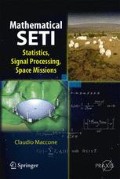Abstract
Darwinian evolution theory may be regarded as a part of SETI theory in that the factor fl in the Drake equation represents the fraction of planets suitable for life on which life actually arises.
Access this chapter
Tax calculation will be finalised at checkout
Purchases are for personal use only
Preview
Unable to display preview. Download preview PDF.
References
Robert A. Rohde and Richard A. Muller, “Cycles in fossil diversity,” Nature, 434 (2005), 208–210.
Claudio Maccone, “The KLT (Karhunen–Loève Transform) to extend SETI searches to broad-band and extremely feeble signals,” Acta Astronautica, 67 (2010), 1427–1439.
A. Szumski, “Finding the interference: The Karhunen–Loève Transform as an instrument to detect weak RF signals,” InsideGNSS (Working Papers), May/June 2011, 56–63.
C. Maccone, “A mathematical model for evolution and SETI,” Origin of Life and Evolutionary Biospheres (OLEB), available online December 3, 2011
Further Reading
Balazs, B. (1988) “The Galactic belt of intelligent life”, in G. Marx (Ed.), Bioastronomy: The Next Steps, Kluwer Academic, pp. 61–66.
Burchell, M. J. (2006), “W(h)ither the Drake equation?” International Journal of Astrobiology, 5, 243–250.
Čirkovič, M. M. (2004), “On the temporal aspect of the Drake equation and SETI,” Astrobiology, 4, 225–231.
Čirkovič, M. M. and Bradbury, R. J. (2006),“Galactic gradients, postbiological evolution and the apparent failure of SETI,” New Astronomy, 11, 628–639.
Gonzalez, G. (2005), “Habitable zones in the Universe,” Origin of Life and Evolution of the Biosphere, 35, 555–606.
Gonzalez, G., Brownlee, D., and Ward, P. (2001), “The Galactic habitable zone: Galactic chemical evolution,” Icarus, 152, 185–200.
Ksanfomality, L. V. (2004), “The Drake equation may need new factors based on peculiarities of planets of Sun-like stars,” in Planetary Systems in the Universe: Proceedings of IAU Symposium d202, p. 458.
Lineweaver, C. H., Fenner, Y., and Gibson, B. K. (2004), “The Galactic habitable zone and the age distribution of complex life in the Milky Way,” Science, 303, 59–62.
Maccone, C. (2008), “The statistical Drake equation,” paper dIAC-08-A4.1.4 presented on October 1, 2008, at the 59th International Astronautical Congress (IAC) held in Glasgow, Scotland, U.K., September 29–October 3, 2008.
Maccone, C. (2010), “The statistical Drake equation,” Acta Astronautica, 67, 1366–1383.
Maccone, C. (2010), “The statistical Fermi paradox,” Journal of the British Interplanetary Society, 63, 222–239.
Maccone, C. (2011), “SETI and SEH (Statistical Equation for Habitables),” Acta Astronautica, 68, 63–75.
Marochnik, L. S. and Mukhin, L. M. (1988), “Belt of life in the Galaxy”, in G. Marx (Ed.), Bioastronomy: The Next Steps, Kluwer Academic, pp. 49–59.
Wallenhorst, S. G. (1981), “The Drake equation reexamined,” QJRAS, 22, 380.
Walters, C., Hoover, R. A., and Kotra, R. K. (1980), “Interstellar colonization: A new parameter for the Drake equation?” Icarus, 41, 193–197.
Author information
Authors and Affiliations
Corresponding author
Rights and permissions
Copyright information
© 2012 Springer-Verlag Berlin Heidelberg
About this chapter
Cite this chapter
Maccone, C. (2012). A mathematical model for evolution and SETI. In: Mathematical SETI. Springer Praxis Books(). Springer, Berlin, Heidelberg. https://doi.org/10.1007/978-3-642-27437-4_8
Download citation
DOI: https://doi.org/10.1007/978-3-642-27437-4_8
Published:
Publisher Name: Springer, Berlin, Heidelberg
Print ISBN: 978-3-642-27436-7
Online ISBN: 978-3-642-27437-4
eBook Packages: Physics and AstronomyPhysics and Astronomy (R0)

